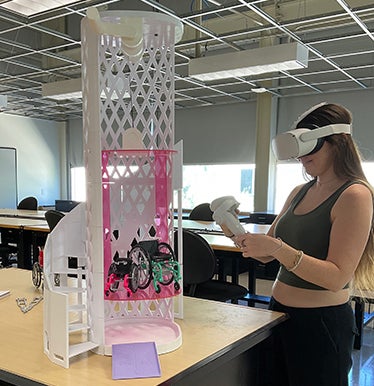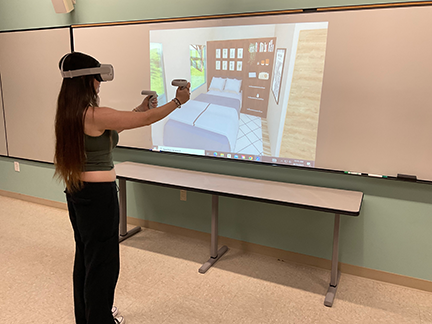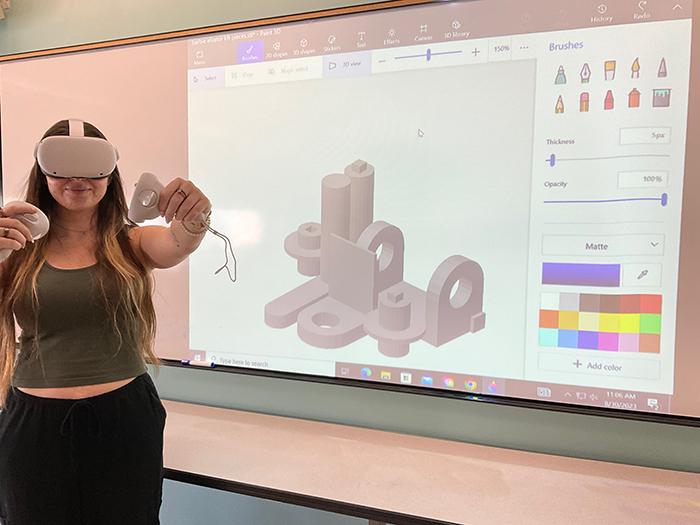Lighting the Way Forward: CSUN Interior Design Program Awarded $84,000 Angelo Donghia Foundation Grant for Students to Transform Lighting-Design Lab

Lighting affects how we sleep, how we wake, and our ability to concentrate or to relax. But day to day, place to place, how often do we consider how the lighting in our environment influences us? It’s not really something most of us think about unless it’s bothering us.
For interior designers, understanding lighting is critical to the talent and skill they bring to their work. Faculty in the CSUN Interior Design (ID) program in the Department of Family and Consumer Sciences (FCS) Kristin King, Hessam Ghamari, and Nasrin Golshany have obtained an $84,000 grant from the Angelo Donghia Foundation for the project, Lighting the Way Forward: Empowering Students Through Experiential Learning in the Transformed Lighting Design and Materials Lab.
The project will dramatically expand the lighting and design resources available to ID students by transforming the lab into a dynamic physical and virtual place for discovery.
The size of the current 1,023 square foot lab will remain the same but that’s about all that won’t change. The lab has had minor upgrades over the years, but overall, its design goes back to the late 1990s. Over the next two years, the changes brought about by, Lighting the Way Forward will also bring students and faculty increased engagement with other areas of the campus community.
Hessam Ghamari, a principal on the grant who instructs some of the courses that will be impacted said, "This grant will enhance our existing infrastructure, with a specific focus on refining the domains of lighting design, materials, finishes, and the integration of cutting-edge Augmented Reality and Virtual Reality [AR/VR] technology.”
“These areas stand as vital pillars within the realm of interior design education,” he added. “The revitalized and newly established labs will increase our students' capacity to engage in visual and tactile learning modalities, which inherently benefit design scholars and their diverse learning preferences."
Ghamari also said that the grant’s investment incorporating AR/VR technology promises to enhance student success and industry achievement in interior design. “The enriched learning environment will align students’ education with industry trends, so they will gain practical skills and knowledge that will empower them for successful careers while contributing to a more competitive and dynamic industry landscape.”
Among its many features, the new lab will have zoned work areas with new light testing equipment, a virtual reality area, and a designated student collaboration area.
ID students will study educational, healthcare, office, residential, and retail spaces to learn to design lighting that will enhance user experiences, whether this means visual comfort, wayfinding, or navigating from one space to another—and they will be able to manipulate the sensual qualities of a space—how a space makes a person feel.
 With the technology, students will be able to test and gauge color temperature, angle of light effectiveness, and daylight sensing in interior spaces. Kristin King, a principal on the grant and ID program coordinator said, “The virtual aspect means students can design lighting for environments in ways that have not been feasible in the lab before. Virtual learning opens a tremendous amount of possibility for students to experiment with greater varieties of materials and designed environments.”
With the technology, students will be able to test and gauge color temperature, angle of light effectiveness, and daylight sensing in interior spaces. Kristin King, a principal on the grant and ID program coordinator said, “The virtual aspect means students can design lighting for environments in ways that have not been feasible in the lab before. Virtual learning opens a tremendous amount of possibility for students to experiment with greater varieties of materials and designed environments.”
Light field cameras can teach students about the effect of direction and intensity of light, and daylight simulation software can show students how to adjust the amount and distribution of light in a space to optimize the ways artificial light might benefit a particular environment. Wearable lighting devices can be used to create interactive lighting effects that respond to changes in movement or sound.
“At the same time,” King added, “students will have unlimited access to material library locations worldwide and will be able to obtain thousands of new and innovative physical materials on demand through the online database, Material ConneXion.”
Ghamari said, “On the grander scale of CSUN priorities, this transformation of the lighting and materials lab establishes a vibrant atmosphere of active learning, reflecting CSUN's core commitment to practical and experiential education.”
The new lab will feature:
- Virtual Reality (VR) headsets for immersive virtual reality experiences so students can visualize different lighting scenarios with different materials
- Augmented Reality (AR) glasses to superimpose virtual objects and lighting effects onto the real-world so they can experiment with lighting and concepts
- Interactive physical lighting fixtures that respond to human movement or touch
- Haptic feedback devices to simulate the sensation of touch via VR and AR environments, to get a realistic experience different materials and lighting
- Gesture control devices for to control lighting and other environmental elements in virtual environments with greater interactivity and control
- 360 degree cameras to create immersive VR experiences and visualizations
- Updated VR/AR software to create custom lighting simulations and interactive experiences
- Flat LED panels that create unique effects such as backlighting, color changing, and pattern projection
- Integratable wireless lighting systems that can work with smart-home technologies such as voice assistants and sensors that will allow students to monitor environmental conditions such as temperature and humidity
About the Angelo Donghia Foundation: Founded in 2001 in honor of the late American designer Angelo R. Donghia, the foundation has provided grants to interior design programs as well as scholarships to deserving students who are pursuing degrees in interior design.
About the CSUN Interior Design (ID) program: The CSUN Interior Design program (Department of Family and Consumer Sciences, College of Health and Human Development) prepares students to analyze, design, and implement living/working environments that are functionally efficient and aesthetically satisfying to diverse populations. The program embraces an environmental and behavioral relationship between people at various ages and developmental stages and the interior environments they occupy. CSUN ID students get experiential learning opportunities through labs and studio courses, and internships in professional settings. They develop leadership skills through Professional Organizations and the national honor society, Kappa Omicron Nu.
F2023
Jean O'Sullivan/HHD
Photography: Kristin King, Hessam Ghamari, Nasrin Golshany

